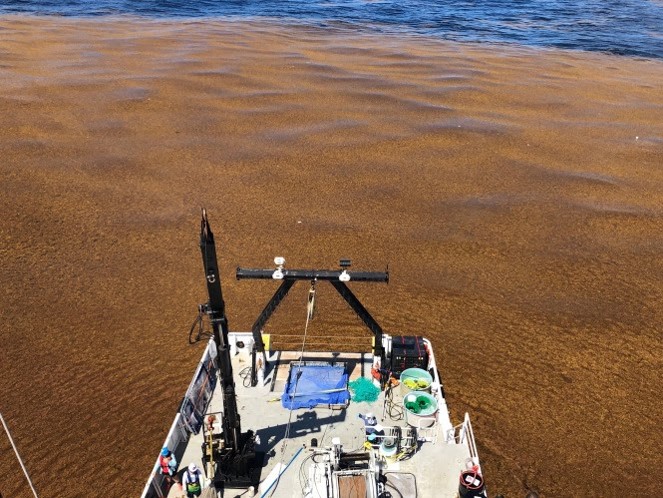Did you know the brown seaweed that washes up at the beach is a biologically important habitat? With support from the NOAA RESTORE Science Program, a team led by Dr. Frank Hernandez is searching for this seaweed, also known as sargassum, in the Gulf of Mexico and gaining a better understanding of its importance to fisheries. They are exploring how changes in weather, ocean conditions, and climate affect where sargassum is located and how it is growing. They are also learning how juvenile fish are using sargassum to survive and grow in the open ocean. The project team is sharing its findings about sargassum with fisheries managers who are responsible for managing the recreationally and commercially important fishes in the Gulf of Mexico that depend on sargassum as critical nursery habitat. Overall, the project team is rapidly expanding what we know about this dynamic open ocean habitat, including ways pollution from land may be impacting the juvenile fish that live there.

In 2017, co-investigator Dr. Chuanmin Hu and his team began their work by compiling remote sensing data and refining mathematical algorithms to better detect sargassum and to produce sargassum location and biomass abundance maps. The team developed a biomass conversion factor, which converts area estimates from satellite data to biomass estimates. Their biomass conversion factor was utilized in a recent publication in the prestigious journal Science. The ability to estimate biomass from satellite data was a major accomplishment. The team is now moving onto improving a sargassum forecasting system. The team’s forecast system will take information about weather and climate conditions’ influence on the location and abundance of sargassum in the past and predict location and abundance in the future. The forecast system is being developed through statistical analyses of the relationship between the observed sargassum abundance and weather conditions, such as wind and climate patterns, like the El Niño–Southern Oscillation which affects the distribution of rainfall in the tropics and weather across the globe.
In addition to these successes, the team has found a clever way to broaden their research. As part of the project, hundreds of fish samples were collected to identify the species associated with sargassum. Graduate student Olivia Lestrade is using these samples to study microplastic ingestion by the juvenile fishes that live in the sargassum. Microplastics are small pieces of plastic less than five millimeters long that pollute the environment. Most microplastics are buoyant and float on the ocean surface where winds and oceanographic processes concentrate them with sargassum along frontal features and “weedlines”. As a result, there is potential for sargassum-associated juvenile fishes to ingest microplastics more frequently than those that live in open water. Ingestion of microplastics could impact juvenile fish health, either as physical obstructions or as vectors of pollutants and microbes, which could ultimately impact growth and survival. Lestrade examined the stomach contents of collected fish for microplastic frequency. Her results suggest that microplastic concentrations are significantly higher in sargassum habitats than in open water, which may make sargassum-associated fishes more susceptible to microplastic ingestion. She also found that more triggerfishes and filefishes consume plastic than other fishes, which may suggest that feeding types, such as grazers, are more susceptible to microplastic ingestion than others.
Because sargassum habitats serve as a nursery for commercially and recreationally important fishes, knowing the abundance and location of sargassum is an essential piece of knowledge for fisheries management. A sargassum forecasting system will enable fisheries managers to plan for future variability of this habitat and the fishes associated with it. The microplastic research provides an evaluation of what else might be in sargassum habitats and advances our understanding of the health impacts of microplastic ingestion by sargassum-associated fishes. By exploring the dynamics of sargassum habitat in the Gulf of Mexico, Dr. Hernandez and his team are setting the stage for substantial advances in fisheries management in the Gulf of Mexico.
Over the last several years the abundance of sargassum has also presented a growing challenge for beach communities in the Caribbean, Mexico, and other regions with large blooms of seaweed being washed up on beaches. These events have greatly impacted tourism, public health, local marine ecosystems, and the quality of life in those areas. In addition to benefiting fisheries managers, a sargassum forecasting system will help island nations and tourist-related industries anticipate and prepare for future sargassum beaching events.
For more information on the project visit: https://restoreactscienceprogram.noaa.gov/projects/sargassum
Also explore the blog for Dr. Frank Hernandez’s lab: https://hernandezfishecologylab.wordpress.com/
 Official websites use.gov
A .gov website belongs to an official government organization in the United States.
Official websites use.gov
A .gov website belongs to an official government organization in the United States.
 Secure .gov websites use HTTPS
A lock or https:// means you’ve safely connected to the .gov website. Share sensitive information only on official, secure websites.
Secure .gov websites use HTTPS
A lock or https:// means you’ve safely connected to the .gov website. Share sensitive information only on official, secure websites.